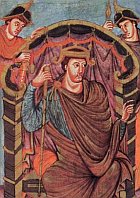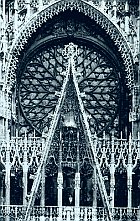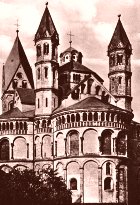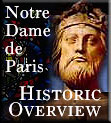

Art Periods and Styles related to
Gothic Architecture :
 Carolingian civilization is recognized as the foundation of Middle Age Europe although the artistic advances of this period were initiated by Martel's grandson Charlemagne, who was crowned Holy Roman Emperor in 800.
Carolingian civilization is recognized as the foundation of Middle Age Europe although the artistic advances of this period were initiated by Martel's grandson Charlemagne, who was crowned Holy Roman Emperor in 800.Image at right : Carolingian era manuscript detail, c. 850, picturing Lothair I, Holy Roman Emperor, flanked by the evangelists.
The Carolingian empire itself did not survive past the ninth century, although, the forces set in motion during this era would inspire cultural expression and growth well through the Medieval age. Rare extant Carolingian architecture remains; the Palatine Chapel in Aachen and the West end of the Imperial Abbey of Corvey being perhaps the finest examples.

Image at right : Exterior of Rose window at Rouen cathedral, France; an ideal example of the Flamboyant style.

Image at right : Exterior of St. Aposteln church, Cologne, Germany; one of twelve surviving Romanesque churches pre-dating the city's Gothic cathedral.
Many cathedrals and churches consist of a blending of Gothic/Romanesque elements; Canterbury, within its 11th century Crypt.
“It is the business of a student of art and not of other men to write a history "from the monuments"; but in face of the problems connected with these half ruined or wholly destroyed buildings there must be sought the help of the reader of inscriptions, the decipherer of hieroglyphs and arrow-head characters, the student of comparative chronology, the practised and judicious reader of the books left us from antiquity, the curious searcher among vestiges of by-gone beliefs and superstitions.
 The artist cannot form his critical judgment of the ancient artist's work until by the aid of all those scholars, and by means of his own choice among the divergent and contradictory opinions which they offer, he has created in his own mind an image of what the lost building or the ruined building was really like. The practised builder is quicker than another to judge aright how the ancients builded, and the decorative designer who is familiar with the decoration of many lands and times is more to be trusted than another in his judgment of the artistic purpose of old Greek or older Egyptian; but as builder and decorator alike, the artist needs the help of the scholar, in puzzling out the significance of what has been left us by earthquake and flood, and the more destructive hands of ignorant men.”
The artist cannot form his critical judgment of the ancient artist's work until by the aid of all those scholars, and by means of his own choice among the divergent and contradictory opinions which they offer, he has created in his own mind an image of what the lost building or the ruined building was really like. The practised builder is quicker than another to judge aright how the ancients builded, and the decorative designer who is familiar with the decoration of many lands and times is more to be trusted than another in his judgment of the artistic purpose of old Greek or older Egyptian; but as builder and decorator alike, the artist needs the help of the scholar, in puzzling out the significance of what has been left us by earthquake and flood, and the more destructive hands of ignorant men.”
“It is commonly supposed, and architects themselves in older days believed it, that an architect's business was to be an expert in style. Why he should be so was never explained. Modern practitioners have kept up a 'battle of the styles' without any such basis for their logic, or rather their eloquence. But what is or was a style? It is a museum name for a phase of past art. As a means of classifying what is dead and done the style labels are quite useful. It has, however, to be kept in mind that these styles, while they lived and moved, were processes which began, continued, and passed into something else. They were only phases like those of the changing moon. That which now professes to be designed in a style has not the essence of life. It is, therefore, not actually of the style which it simulates but is only in the 'style' of the style.
Indeed, the essence of all the old arts was in their vitality, their response to the natural conditions and the psychology of their times. The better we seem to reproduce their dead images the more we are unlike their soul-selves. There is little more reason for an architect to pretend to work in a style than there is for a chemist.”
—William R. Lethaby,Form In Civilization, 1922
“The complaint of the French artist against the Norman is the "mesquin" treatment of dividing his tower into storeys of equal height. Even in the twelfth century and in religious architecture, artists already struggled over the best solution of this particularly American problem of the twentieth century, and when tourists return to New York, they may look at the twenty-storey towers which decorate the city, to see whether the Norman or the French plan has won; but this, at least, will be sure in advance:—the Norman will be the practical scheme which states the facts, and stops; while the French will be the graceful one, which states the beauties, and more or less fits the facts to suit them. Both styles are great: both can sometimes be tiresome.”
—Henry Adams,Mont-Saint-Michel and Chartres, 1904

“In spite of several fine palaces of the Early Renaissance—and one really excellent example of what the usually vulgar, exaggerated, and theatrical Rococo style could achieve in the hands of a capable and delicate minded Italian architect of the seventeenth century, Santa Maria di Provenzano—Siena is essentially a Gothic city. Her position on the hilltops settled that, if it be true that the level lines and broad masses of Classic buildings require the widely spreading plain or open seashore for their fitting development. But the Pointed Style in Italy has little in common with mediæval buildings in France or England, and the student must be prepared to look for quite other beauties than those he is accustomed to trace in northern Cathedrals.”
—Gilbert Hastings,Siena, its Architecture and Art, 1902
Bibliography
Matthew Holbeche Bloxam, London, D. Bogue (1846)
Eugène Viollet-le-Duc, Paris (1858-68)
Development & Production Credits
Primary Text : Rhey Cedron — Theme Editor : Nicole MarchStructural Design & Project Direction : Rhey Cedron
Art Direction : Thierry Alberto — Art Production : Mark Nelson & Ash' Murti
Principal Photography : Rhey Cedron
Art Research : Malcolm Hurrell — Support Research : Walter McCrae
(Life) Support Production : Henry Craig, Joan Flandrin, Clara Kelly and
a Patient Legion of Friends, Family & Angels
cultural projects. Ask to receive your free newsletter
Your questions or comments are always welcome!
Gothic Dreams E-mail
Individual use of enclosed material is encouraged for the purposes of education and enjoyment.
The republication of textual or graphic content, without license, is an infringement of Copyright laws.

